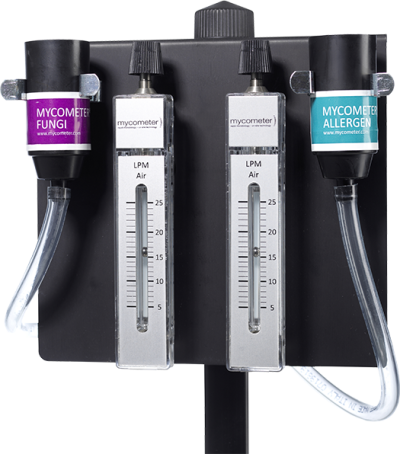The Fungal to Allergen Index – FAI
The new tool for investigating fungal problems in buildings
What is FAI?
Fungal to Allergen Index or FAI is a tool developed to assist the visual (and odor) assessment of buildings. It is based on air sampling, and the primary objective is to give an indication of the presence of a fungal source (fungal or mold growth). In addition, it gives you the potential exposure level of both fungi and total allergens.
In all rooms there is an accumulation of dust. In the dust there are particles from many organic as well as inorganic sources. The organic particles typically found in the dust are pollen, skin cells/dander from humans and pets, dust mites, fungi, insect parts and more. Many of these particles contains allergens, which are typically enzymes.
The FAI concept assumes that in rooms with a fungal source (mold growth), there is a higher-than-normal accumulation of fungal particles leading to a higher relative content of fungi to the total level of allergens.
How is it performed?
Two air samples are taken simultaneously side by side. Sampling time is 10 minutes with a flowrate ≥ 10 lpm. through both filters.
Mycometer’s protocol for standardized activated air sampling must be used.
One sample is analyzed for the total level of allergens (pollen, dust mites, fungi, pet dander, insects etc.). The other sample is analyzed for the level of fungi.
Results and interpretation
Analyzing the content of the two filters gives not two but three results. The level of Fungi, the level of total allergens and the FAI value.
Table 1 below shows the result of a FAI sample in a bedroom. Categories A+, A and B constitute the level typically found in non-problem buildings.
The level of fungi is high (category C) and the level of total allergens is very high (category D). The FAI value is however only 3%. The interpretation is that the potential exposure to both fungi and allergens are high (very high for total allergens). The FAI value of 3% means that there are no sources of fungal growth that affect the room.
The high levels of both fungi and total allergens indicate a high accumulation of naturally occurring fungi and other allergens likely caused by a deficient cleaning level.


Table 2 shows the result from a kitchen. The level of fungi was high (category C), while the level of total allergens were normal (category A). The FAI value was 98%. The potential exposure to fungi is high (compared to what is found in non-problem buildings), while the potential exposure to total allergens is normal. A FAI value of 98% means that there is a fungal source (mold growth) in or in the vicinity of the room where the sample was taken.
The real value of the FAI concept can be seen from the fact that the level of fungi in the two shown rooms are almost the same but the conclusion is completely opposite when it comes to the presence of a fungal source.

The interpretation criteria



